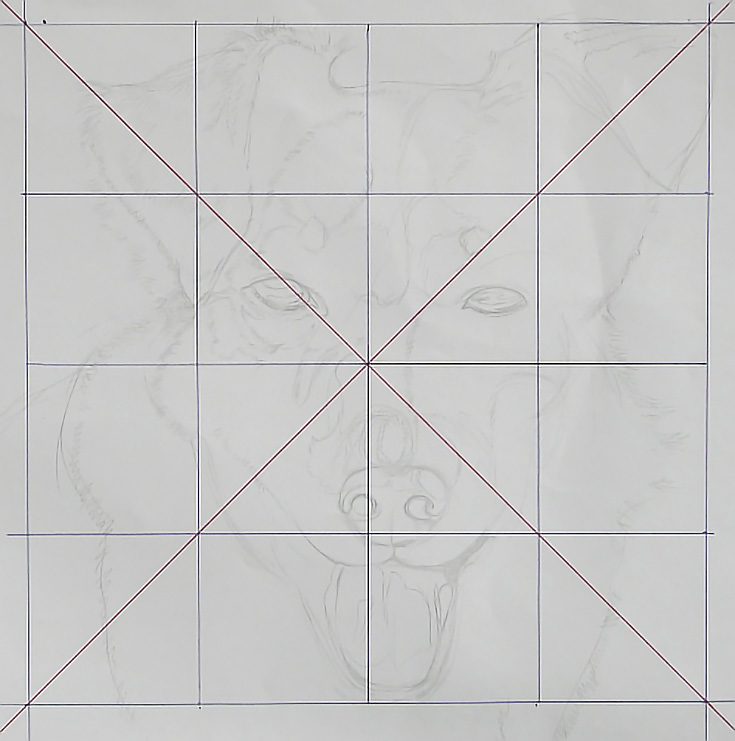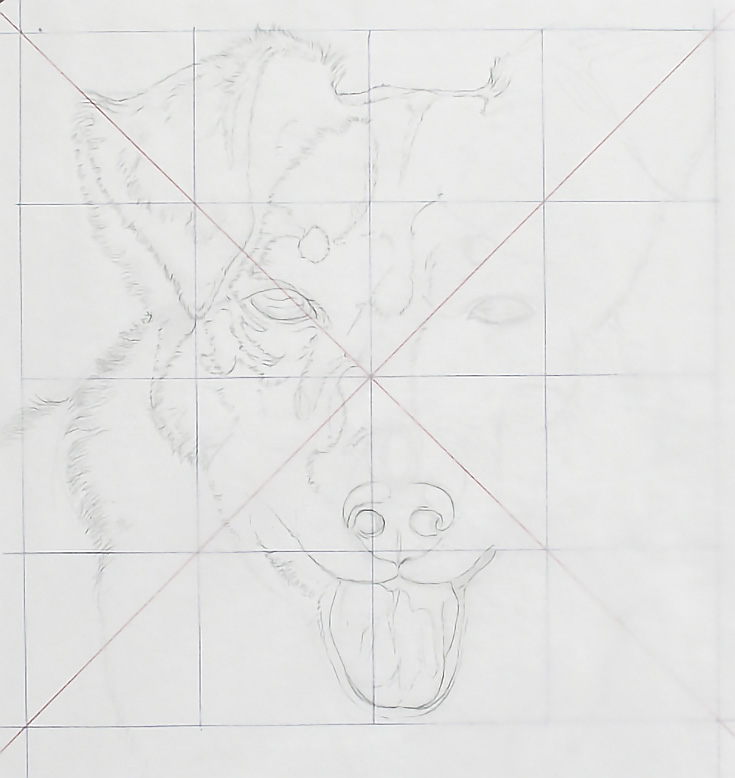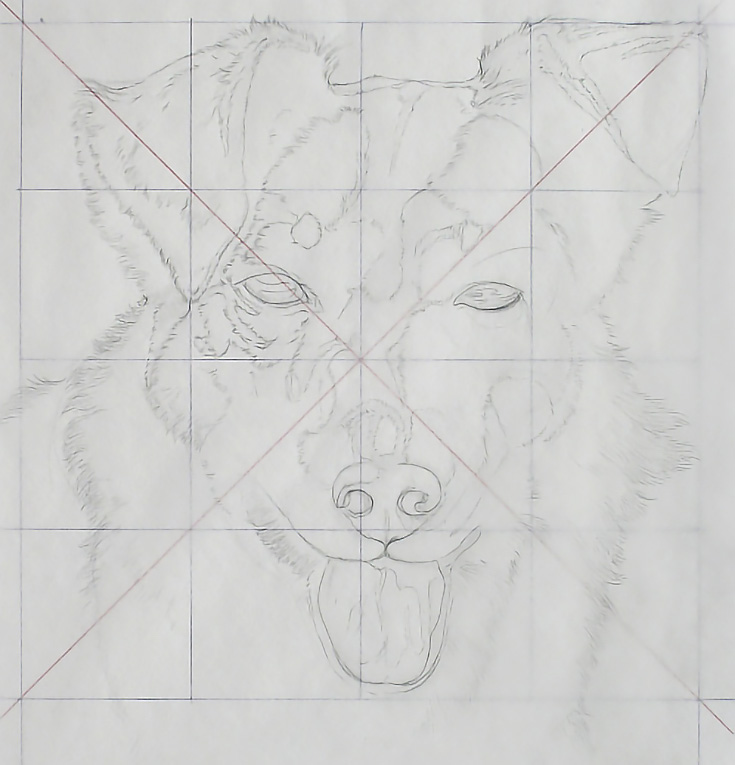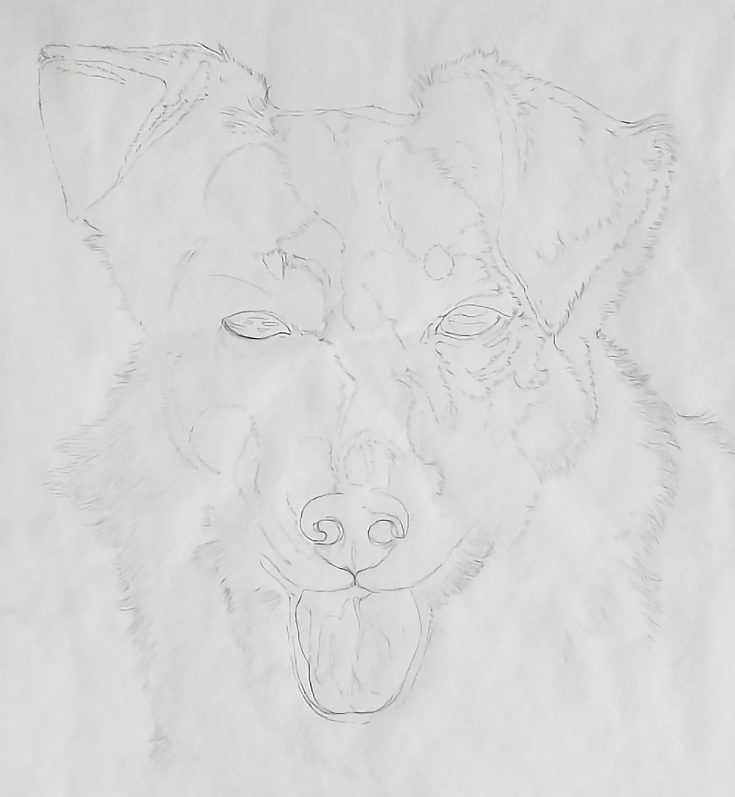In one of my previous articles I described how I add a grid to my reference photos before starting a drawing. Here’s what I had at the end of that article:
Today I’m going to pick up where I left off and describe my actual drawing process. Although I’m using a dog portrait as a demonstration piece, this method works with any subject.
1. Add a grid to your drawing paper
It’s a painstaking job to draw an accurate grid by hand, which is why I prefer to print this grid on my paper whenever possible. However, in this case the size of this portrait (16×20) makes it too large to print—so I did have to hand-draw it.
Luckily, this grid is square, which made calculating it’s size and placement fairly easy. I just needed to decide how large the grid should be on my paper before using a ruler or straight-edge to put the grid in place.
NOTE: A good rule of thumb when drawing portraits is that the subject should take up at least half of the width of the paper. Since the width of my paper is 16 inches, 8 inches is as small as the grid should be.
Since the grid on my reference photo contains a little bit of the dog’s shoulder, I made my drawing grid 9-1/2 inches wide (and tall). This means her face should measure slightly over 8 inches.
2. Rough in your drawing
I began my drawing by putting in basic shapes (nose, mouth, eyes, and ears) as accurately and quickly as possible. I didn’t want to get bogged down in detail too quickly, but it still took about 30 minutes to do the basic rough draft with a medium hardness pencil. Then I sketched in the rest of the head and features with light, gestural strokes.
The lines of the grid (horizontal, vertical, and diagonal) helped me see exactly where each feature should appear on my drawing paper. Drawing what I saw in my reference photo became more about creating abstract shapes and intersecting lines rather than drawing an “eye” or an “ear.”
3. Refine your drawing
Once the drawing was roughed in to my satisfaction, I worked through a series of revisions. A simple drawing may take only one or two revisions. A more complex one may go through a half dozen or more revisions.
For revisions, I taped tracing paper over the gridded drawing and worked through the first revision on the tracing paper. This preserves the original drawing (in case I make a major mistake) and allows me to work with the grid a little bit longer.
The illustration above shows my drawing half-finished on tracing paper—I’m working from the top-left over. Below is the finished drawing on tracing paper, still mounted over the top of the original drawing.
4. Turn your paper over to correct mistakes
Because I’m right-handed, I tend to draw with a right-handed bias. Flipping over a drawing helps me spot mistakes, and gives me a fresh view of my composition. It also allows me to correct any mistakes. This is the primary reason I use tracing paper.
Here is the drawing viewed from the front (I’ve removed it from the grid drawing to make it easier to see).
Below is the same drawing, but I’ve flipped it to view it from the back.
And here is the original reference photo also shown in reverse for comparison.
Overall, the drawing is fairly accurate, but I’m able to see some inaccuracies in the shape and placement of the eyes and the nose.
Whenever I make corrections on the back of a drawing, I use a colored pencil so I can tell one set of lines from another. In this case, I used a red pencil to redraw the eyes and the nose on the back of my tracing paper. I outlined the eye on the right, then redrew the opposite eye. The nose was also redrawn, along with the upper lip to put the nose into context.
The next illustration shows the drawing from the front. I’ve erased the eye, nose, and upper lip which were incorrectly placed, and re-drawn them with graphite on the front. The red lines are still visible, but that’s OK—I’ll leave them as reference points for further revisions.
For this particular portrait, I did a few more revisions, then turned the tracing paper over and displayed it in a place where I would frequently see it over the next few days—I do this because it sometimes takes a while to spot inaccuracies in a drawing.
This process of reviewing the drawing and making changes continues until I’m satisfied that it’s as accurate as I can make it. At that point it’s just a matter of transferring the drawing to the final paper, and filling in all the details and colors.
5. Save your works-in-progress!
Eventually I end up with at least four copies of the drawing in progress. I have the original drawing that I created on my drawing grid, the first tracing paper drawing, the reversed tracing paper drawing, and a final revised drawing on tracing paper.
This may seem like too much work (and a lot of drawings to store!) but if you’re doing a lot of portrait work, it can actually be a good thing.
It’s not unheard of for a portrait to get damaged or destroyed, either in your care or after it has been purchased, and suddenly you need to create a replacement. Having all these drawings in storage is a great safeguard in such a situation—you can pick up right from the last step, without having to redo the entire process over again.
This post may contain affiliate links.









